Detailed Case Study: Sepsis, Septic Shock, and Organ Dysfunction
VerifiedAdded on 2023/06/17
|7
|1878
|457
Case Study
AI Summary
This assignment provides a detailed analysis of a case study involving Zach, an eighteen-year-old patient admitted to the ICU with sepsis and subsequent multi-organ failure. The assignment defines sepsis, identifies the point at which Zach met the sepsis criteria, and discusses the signs and symptoms indicative of septic shock. It further examines the organs meeting the criteria for dysfunction based on the SOFA score, specifically highlighting respiratory and cardiovascular systems on day 2 of ICU admission. The SOFA score of 8 indicates a mortality rate between 15-20%. The analysis underscores the importance of early sepsis recognition and intervention to improve patient outcomes, concluding that sepsis is a life-threatening condition requiring prompt identification and management to prevent organ failure and reduce mortality. Desklib offers a variety of solved assignments and study resources for students.
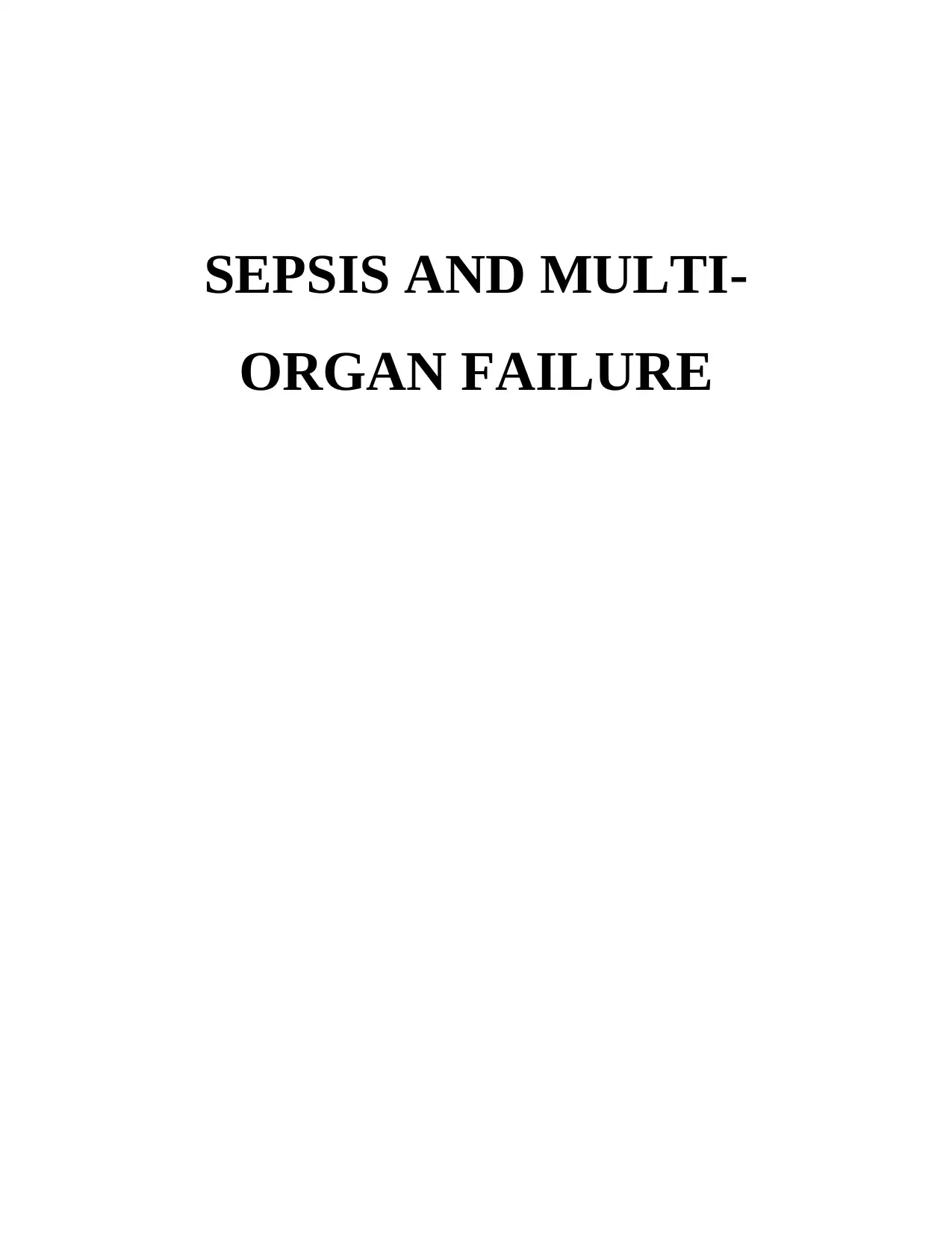
SEPSIS AND MULTI-
ORGAN FAILURE
ORGAN FAILURE
Paraphrase This Document
Need a fresh take? Get an instant paraphrase of this document with our AI Paraphraser
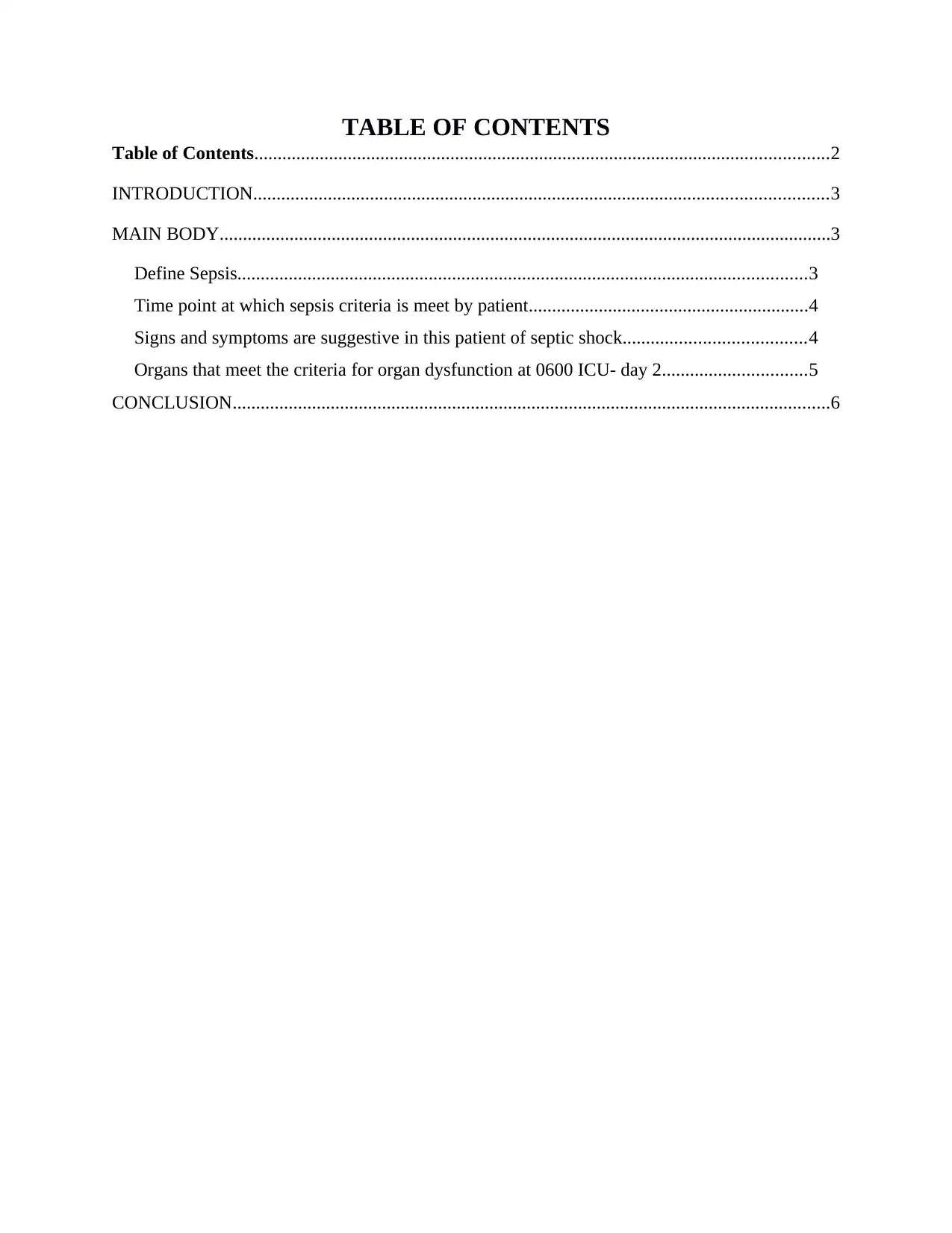
TABLE OF CONTENTS
Table of Contents...........................................................................................................................2
INTRODUCTION...........................................................................................................................3
MAIN BODY...................................................................................................................................3
Define Sepsis..........................................................................................................................3
Time point at which sepsis criteria is meet by patient............................................................4
Signs and symptoms are suggestive in this patient of septic shock.......................................4
Organs that meet the criteria for organ dysfunction at 0600 ICU- day 2...............................5
CONCLUSION................................................................................................................................6
Table of Contents...........................................................................................................................2
INTRODUCTION...........................................................................................................................3
MAIN BODY...................................................................................................................................3
Define Sepsis..........................................................................................................................3
Time point at which sepsis criteria is meet by patient............................................................4
Signs and symptoms are suggestive in this patient of septic shock.......................................4
Organs that meet the criteria for organ dysfunction at 0600 ICU- day 2...............................5
CONCLUSION................................................................................................................................6
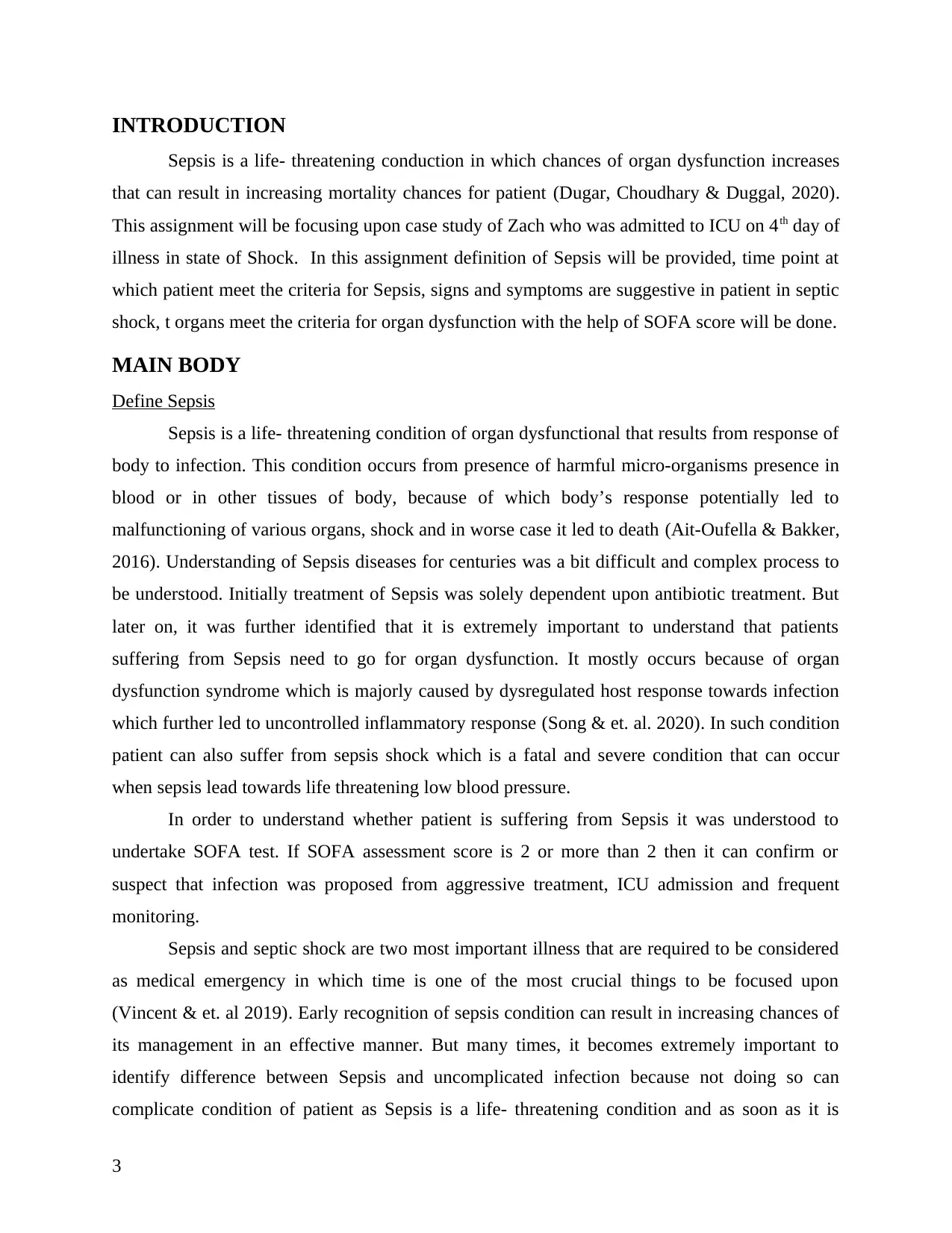
INTRODUCTION
Sepsis is a life- threatening conduction in which chances of organ dysfunction increases
that can result in increasing mortality chances for patient (Dugar, Choudhary & Duggal, 2020).
This assignment will be focusing upon case study of Zach who was admitted to ICU on 4th day of
illness in state of Shock. In this assignment definition of Sepsis will be provided, time point at
which patient meet the criteria for Sepsis, signs and symptoms are suggestive in patient in septic
shock, t organs meet the criteria for organ dysfunction with the help of SOFA score will be done.
MAIN BODY
Define Sepsis
Sepsis is a life- threatening condition of organ dysfunctional that results from response of
body to infection. This condition occurs from presence of harmful micro-organisms presence in
blood or in other tissues of body, because of which body’s response potentially led to
malfunctioning of various organs, shock and in worse case it led to death (Ait-Oufella & Bakker,
2016). Understanding of Sepsis diseases for centuries was a bit difficult and complex process to
be understood. Initially treatment of Sepsis was solely dependent upon antibiotic treatment. But
later on, it was further identified that it is extremely important to understand that patients
suffering from Sepsis need to go for organ dysfunction. It mostly occurs because of organ
dysfunction syndrome which is majorly caused by dysregulated host response towards infection
which further led to uncontrolled inflammatory response (Song & et. al. 2020). In such condition
patient can also suffer from sepsis shock which is a fatal and severe condition that can occur
when sepsis lead towards life threatening low blood pressure.
In order to understand whether patient is suffering from Sepsis it was understood to
undertake SOFA test. If SOFA assessment score is 2 or more than 2 then it can confirm or
suspect that infection was proposed from aggressive treatment, ICU admission and frequent
monitoring.
Sepsis and septic shock are two most important illness that are required to be considered
as medical emergency in which time is one of the most crucial things to be focused upon
(Vincent & et. al 2019). Early recognition of sepsis condition can result in increasing chances of
its management in an effective manner. But many times, it becomes extremely important to
identify difference between Sepsis and uncomplicated infection because not doing so can
complicate condition of patient as Sepsis is a life- threatening condition and as soon as it is
3
Sepsis is a life- threatening conduction in which chances of organ dysfunction increases
that can result in increasing mortality chances for patient (Dugar, Choudhary & Duggal, 2020).
This assignment will be focusing upon case study of Zach who was admitted to ICU on 4th day of
illness in state of Shock. In this assignment definition of Sepsis will be provided, time point at
which patient meet the criteria for Sepsis, signs and symptoms are suggestive in patient in septic
shock, t organs meet the criteria for organ dysfunction with the help of SOFA score will be done.
MAIN BODY
Define Sepsis
Sepsis is a life- threatening condition of organ dysfunctional that results from response of
body to infection. This condition occurs from presence of harmful micro-organisms presence in
blood or in other tissues of body, because of which body’s response potentially led to
malfunctioning of various organs, shock and in worse case it led to death (Ait-Oufella & Bakker,
2016). Understanding of Sepsis diseases for centuries was a bit difficult and complex process to
be understood. Initially treatment of Sepsis was solely dependent upon antibiotic treatment. But
later on, it was further identified that it is extremely important to understand that patients
suffering from Sepsis need to go for organ dysfunction. It mostly occurs because of organ
dysfunction syndrome which is majorly caused by dysregulated host response towards infection
which further led to uncontrolled inflammatory response (Song & et. al. 2020). In such condition
patient can also suffer from sepsis shock which is a fatal and severe condition that can occur
when sepsis lead towards life threatening low blood pressure.
In order to understand whether patient is suffering from Sepsis it was understood to
undertake SOFA test. If SOFA assessment score is 2 or more than 2 then it can confirm or
suspect that infection was proposed from aggressive treatment, ICU admission and frequent
monitoring.
Sepsis and septic shock are two most important illness that are required to be considered
as medical emergency in which time is one of the most crucial things to be focused upon
(Vincent & et. al 2019). Early recognition of sepsis condition can result in increasing chances of
its management in an effective manner. But many times, it becomes extremely important to
identify difference between Sepsis and uncomplicated infection because not doing so can
complicate condition of patient as Sepsis is a life- threatening condition and as soon as it is
3
⊘ This is a preview!⊘
Do you want full access?
Subscribe today to unlock all pages.

Trusted by 1+ million students worldwide
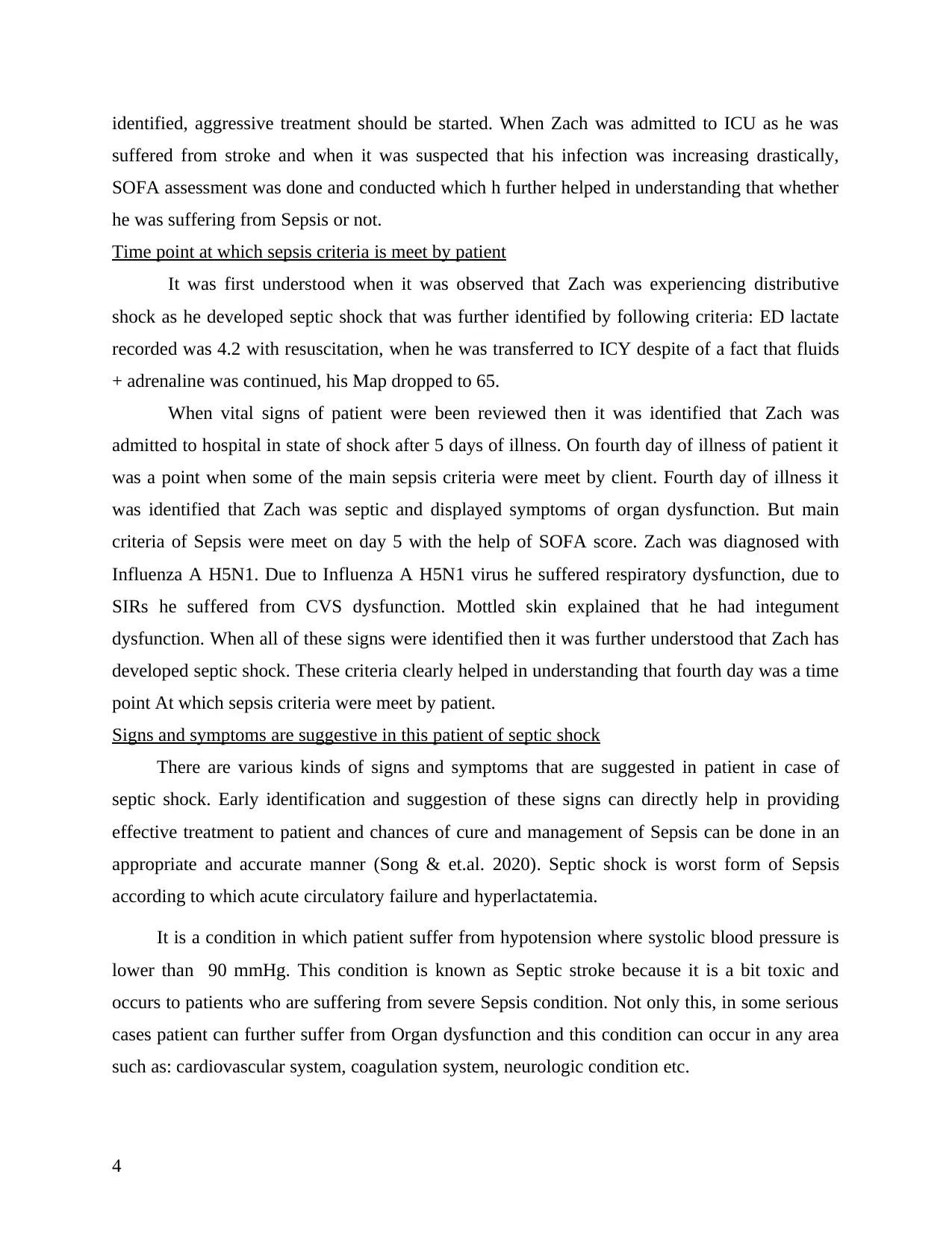
identified, aggressive treatment should be started. When Zach was admitted to ICU as he was
suffered from stroke and when it was suspected that his infection was increasing drastically,
SOFA assessment was done and conducted which h further helped in understanding that whether
he was suffering from Sepsis or not.
Time point at which sepsis criteria is meet by patient
It was first understood when it was observed that Zach was experiencing distributive
shock as he developed septic shock that was further identified by following criteria: ED lactate
recorded was 4.2 with resuscitation, when he was transferred to ICY despite of a fact that fluids
+ adrenaline was continued, his Map dropped to 65.
When vital signs of patient were been reviewed then it was identified that Zach was
admitted to hospital in state of shock after 5 days of illness. On fourth day of illness of patient it
was a point when some of the main sepsis criteria were meet by client. Fourth day of illness it
was identified that Zach was septic and displayed symptoms of organ dysfunction. But main
criteria of Sepsis were meet on day 5 with the help of SOFA score. Zach was diagnosed with
Influenza A H5N1. Due to Influenza A H5N1 virus he suffered respiratory dysfunction, due to
SIRs he suffered from CVS dysfunction. Mottled skin explained that he had integument
dysfunction. When all of these signs were identified then it was further understood that Zach has
developed septic shock. These criteria clearly helped in understanding that fourth day was a time
point At which sepsis criteria were meet by patient.
Signs and symptoms are suggestive in this patient of septic shock
There are various kinds of signs and symptoms that are suggested in patient in case of
septic shock. Early identification and suggestion of these signs can directly help in providing
effective treatment to patient and chances of cure and management of Sepsis can be done in an
appropriate and accurate manner (Song & et.al. 2020). Septic shock is worst form of Sepsis
according to which acute circulatory failure and hyperlactatemia.
It is a condition in which patient suffer from hypotension where systolic blood pressure is
lower than 90 mmHg. This condition is known as Septic stroke because it is a bit toxic and
occurs to patients who are suffering from severe Sepsis condition. Not only this, in some serious
cases patient can further suffer from Organ dysfunction and this condition can occur in any area
such as: cardiovascular system, coagulation system, neurologic condition etc.
4
suffered from stroke and when it was suspected that his infection was increasing drastically,
SOFA assessment was done and conducted which h further helped in understanding that whether
he was suffering from Sepsis or not.
Time point at which sepsis criteria is meet by patient
It was first understood when it was observed that Zach was experiencing distributive
shock as he developed septic shock that was further identified by following criteria: ED lactate
recorded was 4.2 with resuscitation, when he was transferred to ICY despite of a fact that fluids
+ adrenaline was continued, his Map dropped to 65.
When vital signs of patient were been reviewed then it was identified that Zach was
admitted to hospital in state of shock after 5 days of illness. On fourth day of illness of patient it
was a point when some of the main sepsis criteria were meet by client. Fourth day of illness it
was identified that Zach was septic and displayed symptoms of organ dysfunction. But main
criteria of Sepsis were meet on day 5 with the help of SOFA score. Zach was diagnosed with
Influenza A H5N1. Due to Influenza A H5N1 virus he suffered respiratory dysfunction, due to
SIRs he suffered from CVS dysfunction. Mottled skin explained that he had integument
dysfunction. When all of these signs were identified then it was further understood that Zach has
developed septic shock. These criteria clearly helped in understanding that fourth day was a time
point At which sepsis criteria were meet by patient.
Signs and symptoms are suggestive in this patient of septic shock
There are various kinds of signs and symptoms that are suggested in patient in case of
septic shock. Early identification and suggestion of these signs can directly help in providing
effective treatment to patient and chances of cure and management of Sepsis can be done in an
appropriate and accurate manner (Song & et.al. 2020). Septic shock is worst form of Sepsis
according to which acute circulatory failure and hyperlactatemia.
It is a condition in which patient suffer from hypotension where systolic blood pressure is
lower than 90 mmHg. This condition is known as Septic stroke because it is a bit toxic and
occurs to patients who are suffering from severe Sepsis condition. Not only this, in some serious
cases patient can further suffer from Organ dysfunction and this condition can occur in any area
such as: cardiovascular system, coagulation system, neurologic condition etc.
4
Paraphrase This Document
Need a fresh take? Get an instant paraphrase of this document with our AI Paraphraser
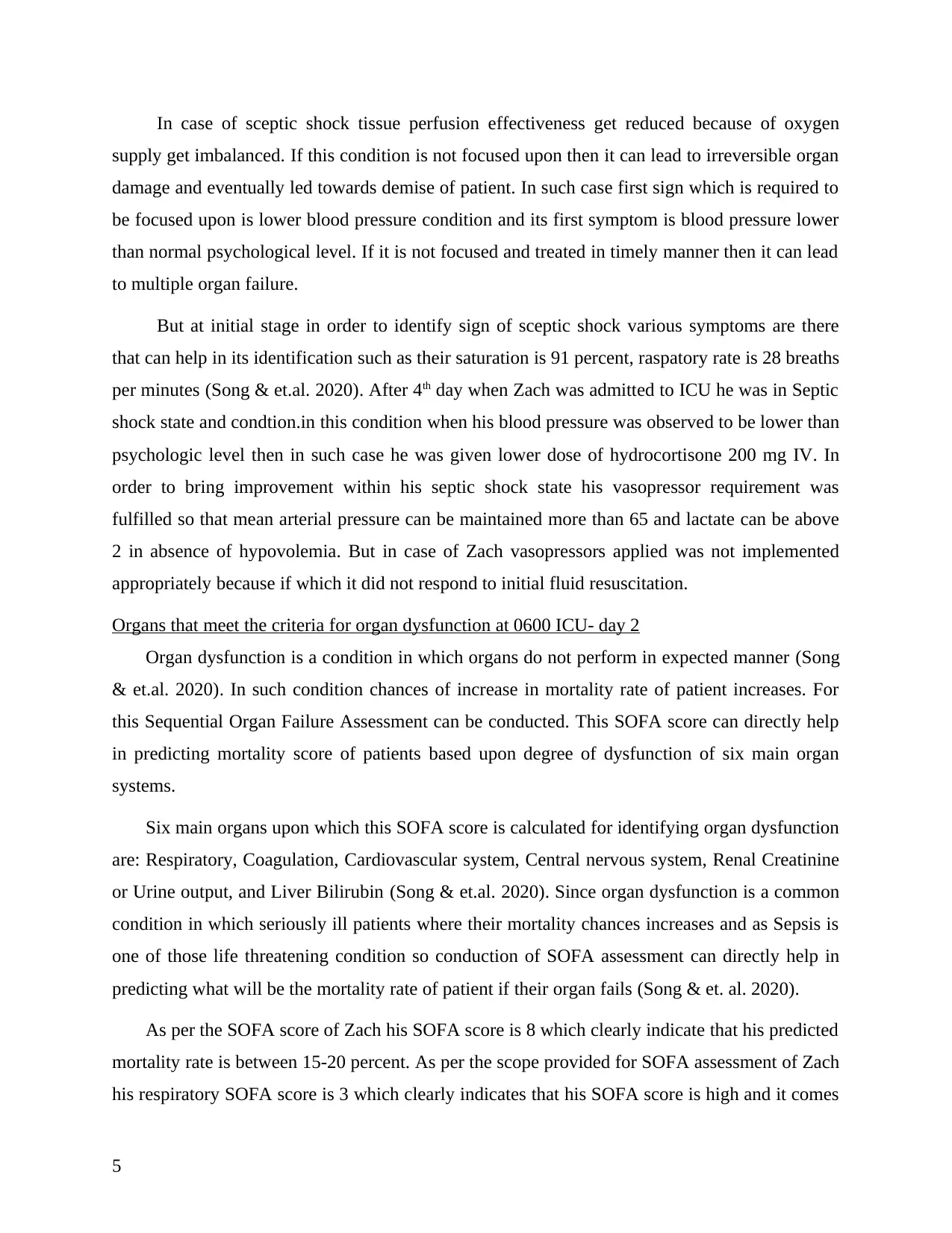
In case of sceptic shock tissue perfusion effectiveness get reduced because of oxygen
supply get imbalanced. If this condition is not focused upon then it can lead to irreversible organ
damage and eventually led towards demise of patient. In such case first sign which is required to
be focused upon is lower blood pressure condition and its first symptom is blood pressure lower
than normal psychological level. If it is not focused and treated in timely manner then it can lead
to multiple organ failure.
But at initial stage in order to identify sign of sceptic shock various symptoms are there
that can help in its identification such as their saturation is 91 percent, raspatory rate is 28 breaths
per minutes (Song & et.al. 2020). After 4th day when Zach was admitted to ICU he was in Septic
shock state and condtion.in this condition when his blood pressure was observed to be lower than
psychologic level then in such case he was given lower dose of hydrocortisone 200 mg IV. In
order to bring improvement within his septic shock state his vasopressor requirement was
fulfilled so that mean arterial pressure can be maintained more than 65 and lactate can be above
2 in absence of hypovolemia. But in case of Zach vasopressors applied was not implemented
appropriately because if which it did not respond to initial fluid resuscitation.
Organs that meet the criteria for organ dysfunction at 0600 ICU- day 2
Organ dysfunction is a condition in which organs do not perform in expected manner (Song
& et.al. 2020). In such condition chances of increase in mortality rate of patient increases. For
this Sequential Organ Failure Assessment can be conducted. This SOFA score can directly help
in predicting mortality score of patients based upon degree of dysfunction of six main organ
systems.
Six main organs upon which this SOFA score is calculated for identifying organ dysfunction
are: Respiratory, Coagulation, Cardiovascular system, Central nervous system, Renal Creatinine
or Urine output, and Liver Bilirubin (Song & et.al. 2020). Since organ dysfunction is a common
condition in which seriously ill patients where their mortality chances increases and as Sepsis is
one of those life threatening condition so conduction of SOFA assessment can directly help in
predicting what will be the mortality rate of patient if their organ fails (Song & et. al. 2020).
As per the SOFA score of Zach his SOFA score is 8 which clearly indicate that his predicted
mortality rate is between 15-20 percent. As per the scope provided for SOFA assessment of Zach
his respiratory SOFA score is 3 which clearly indicates that his SOFA score is high and it comes
5
supply get imbalanced. If this condition is not focused upon then it can lead to irreversible organ
damage and eventually led towards demise of patient. In such case first sign which is required to
be focused upon is lower blood pressure condition and its first symptom is blood pressure lower
than normal psychological level. If it is not focused and treated in timely manner then it can lead
to multiple organ failure.
But at initial stage in order to identify sign of sceptic shock various symptoms are there
that can help in its identification such as their saturation is 91 percent, raspatory rate is 28 breaths
per minutes (Song & et.al. 2020). After 4th day when Zach was admitted to ICU he was in Septic
shock state and condtion.in this condition when his blood pressure was observed to be lower than
psychologic level then in such case he was given lower dose of hydrocortisone 200 mg IV. In
order to bring improvement within his septic shock state his vasopressor requirement was
fulfilled so that mean arterial pressure can be maintained more than 65 and lactate can be above
2 in absence of hypovolemia. But in case of Zach vasopressors applied was not implemented
appropriately because if which it did not respond to initial fluid resuscitation.
Organs that meet the criteria for organ dysfunction at 0600 ICU- day 2
Organ dysfunction is a condition in which organs do not perform in expected manner (Song
& et.al. 2020). In such condition chances of increase in mortality rate of patient increases. For
this Sequential Organ Failure Assessment can be conducted. This SOFA score can directly help
in predicting mortality score of patients based upon degree of dysfunction of six main organ
systems.
Six main organs upon which this SOFA score is calculated for identifying organ dysfunction
are: Respiratory, Coagulation, Cardiovascular system, Central nervous system, Renal Creatinine
or Urine output, and Liver Bilirubin (Song & et.al. 2020). Since organ dysfunction is a common
condition in which seriously ill patients where their mortality chances increases and as Sepsis is
one of those life threatening condition so conduction of SOFA assessment can directly help in
predicting what will be the mortality rate of patient if their organ fails (Song & et. al. 2020).
As per the SOFA score of Zach his SOFA score is 8 which clearly indicate that his predicted
mortality rate is between 15-20 percent. As per the scope provided for SOFA assessment of Zach
his respiratory SOFA score is 3 which clearly indicates that his SOFA score is high and it comes
5
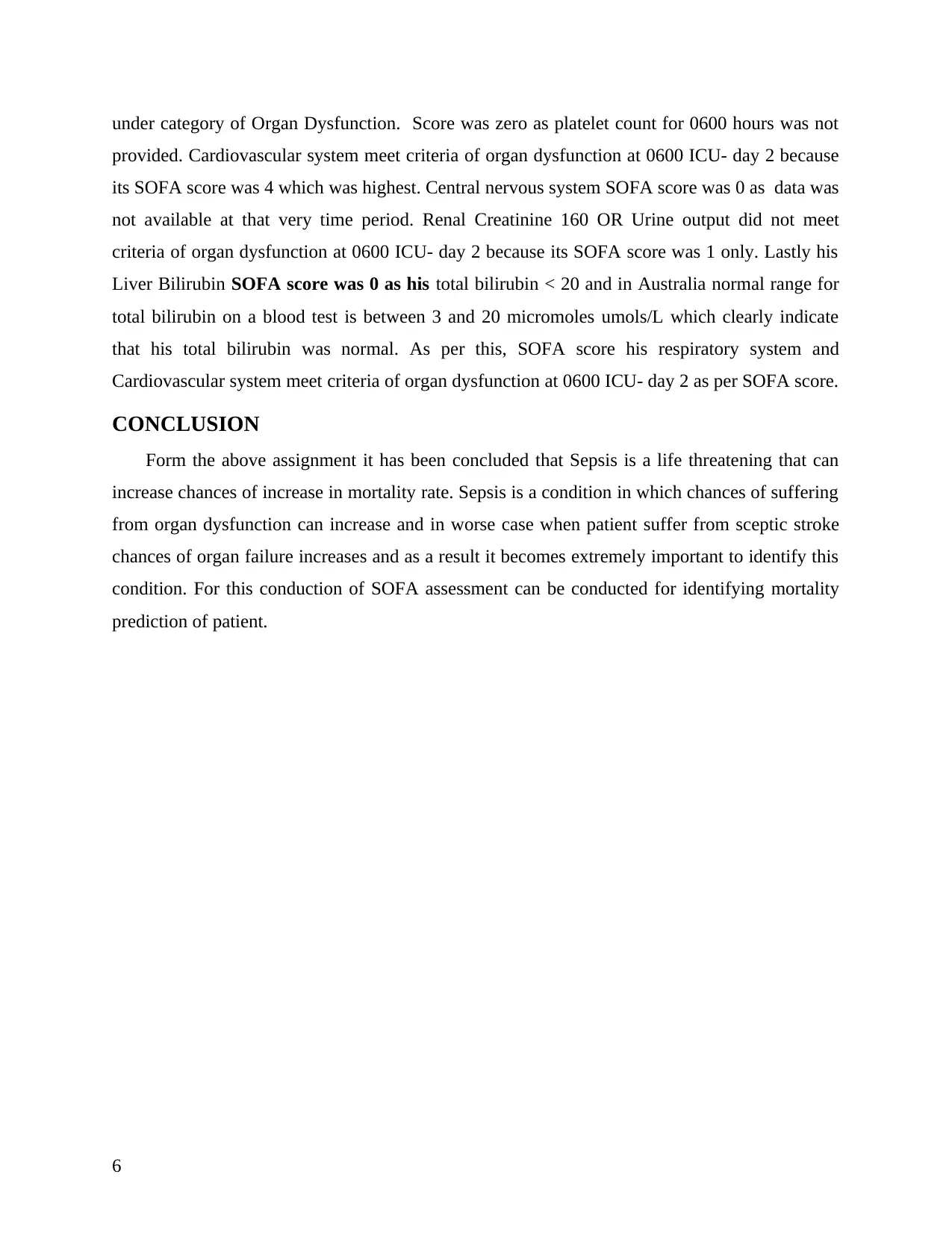
under category of Organ Dysfunction. Score was zero as platelet count for 0600 hours was not
provided. Cardiovascular system meet criteria of organ dysfunction at 0600 ICU- day 2 because
its SOFA score was 4 which was highest. Central nervous system SOFA score was 0 as data was
not available at that very time period. Renal Creatinine 160 OR Urine output did not meet
criteria of organ dysfunction at 0600 ICU- day 2 because its SOFA score was 1 only. Lastly his
Liver Bilirubin SOFA score was 0 as his total bilirubin < 20 and in Australia normal range for
total bilirubin on a blood test is between 3 and 20 micromoles umols/L which clearly indicate
that his total bilirubin was normal. As per this, SOFA score his respiratory system and
Cardiovascular system meet criteria of organ dysfunction at 0600 ICU- day 2 as per SOFA score.
CONCLUSION
Form the above assignment it has been concluded that Sepsis is a life threatening that can
increase chances of increase in mortality rate. Sepsis is a condition in which chances of suffering
from organ dysfunction can increase and in worse case when patient suffer from sceptic stroke
chances of organ failure increases and as a result it becomes extremely important to identify this
condition. For this conduction of SOFA assessment can be conducted for identifying mortality
prediction of patient.
6
provided. Cardiovascular system meet criteria of organ dysfunction at 0600 ICU- day 2 because
its SOFA score was 4 which was highest. Central nervous system SOFA score was 0 as data was
not available at that very time period. Renal Creatinine 160 OR Urine output did not meet
criteria of organ dysfunction at 0600 ICU- day 2 because its SOFA score was 1 only. Lastly his
Liver Bilirubin SOFA score was 0 as his total bilirubin < 20 and in Australia normal range for
total bilirubin on a blood test is between 3 and 20 micromoles umols/L which clearly indicate
that his total bilirubin was normal. As per this, SOFA score his respiratory system and
Cardiovascular system meet criteria of organ dysfunction at 0600 ICU- day 2 as per SOFA score.
CONCLUSION
Form the above assignment it has been concluded that Sepsis is a life threatening that can
increase chances of increase in mortality rate. Sepsis is a condition in which chances of suffering
from organ dysfunction can increase and in worse case when patient suffer from sceptic stroke
chances of organ failure increases and as a result it becomes extremely important to identify this
condition. For this conduction of SOFA assessment can be conducted for identifying mortality
prediction of patient.
6
⊘ This is a preview!⊘
Do you want full access?
Subscribe today to unlock all pages.

Trusted by 1+ million students worldwide
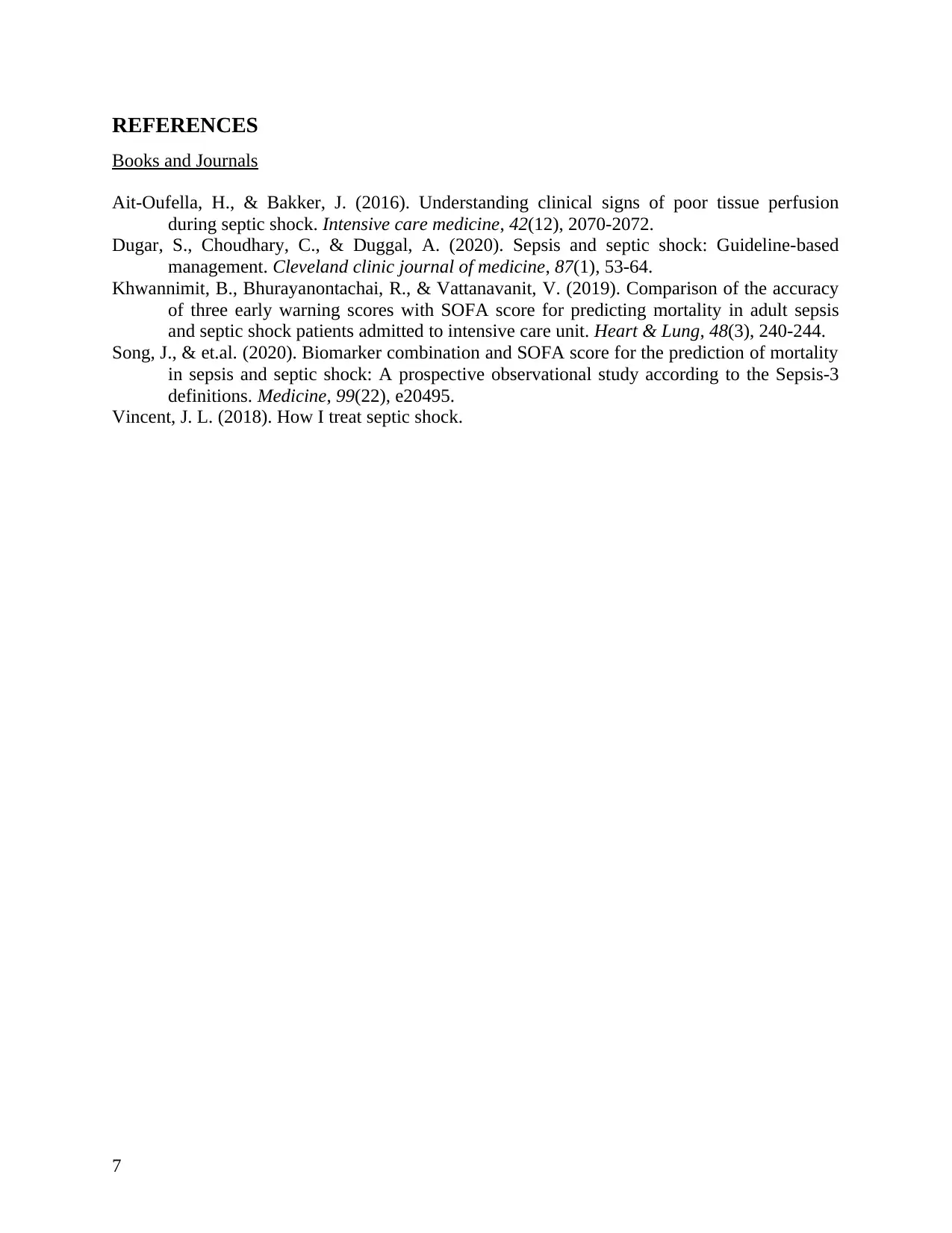
REFERENCES
Books and Journals
Ait-Oufella, H., & Bakker, J. (2016). Understanding clinical signs of poor tissue perfusion
during septic shock. Intensive care medicine, 42(12), 2070-2072.
Dugar, S., Choudhary, C., & Duggal, A. (2020). Sepsis and septic shock: Guideline-based
management. Cleveland clinic journal of medicine, 87(1), 53-64.
Khwannimit, B., Bhurayanontachai, R., & Vattanavanit, V. (2019). Comparison of the accuracy
of three early warning scores with SOFA score for predicting mortality in adult sepsis
and septic shock patients admitted to intensive care unit. Heart & Lung, 48(3), 240-244.
Song, J., & et.al. (2020). Biomarker combination and SOFA score for the prediction of mortality
in sepsis and septic shock: A prospective observational study according to the Sepsis-3
definitions. Medicine, 99(22), e20495.
Vincent, J. L. (2018). How I treat septic shock.
7
Books and Journals
Ait-Oufella, H., & Bakker, J. (2016). Understanding clinical signs of poor tissue perfusion
during septic shock. Intensive care medicine, 42(12), 2070-2072.
Dugar, S., Choudhary, C., & Duggal, A. (2020). Sepsis and septic shock: Guideline-based
management. Cleveland clinic journal of medicine, 87(1), 53-64.
Khwannimit, B., Bhurayanontachai, R., & Vattanavanit, V. (2019). Comparison of the accuracy
of three early warning scores with SOFA score for predicting mortality in adult sepsis
and septic shock patients admitted to intensive care unit. Heart & Lung, 48(3), 240-244.
Song, J., & et.al. (2020). Biomarker combination and SOFA score for the prediction of mortality
in sepsis and septic shock: A prospective observational study according to the Sepsis-3
definitions. Medicine, 99(22), e20495.
Vincent, J. L. (2018). How I treat septic shock.
7
1 out of 7
Related Documents
Your All-in-One AI-Powered Toolkit for Academic Success.
+13062052269
info@desklib.com
Available 24*7 on WhatsApp / Email
![[object Object]](/_next/static/media/star-bottom.7253800d.svg)
Unlock your academic potential
Copyright © 2020–2025 A2Z Services. All Rights Reserved. Developed and managed by ZUCOL.





